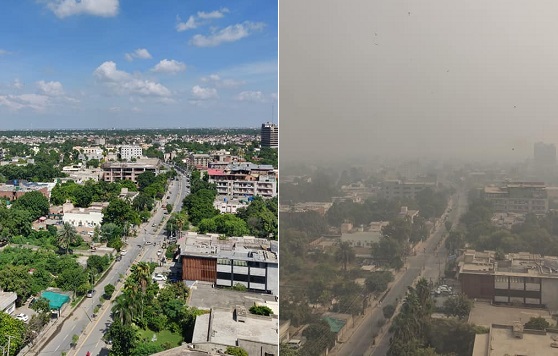This year on August 30, the Punjab government published a grand newspaper supplement titled “Vision Punjab 2021”. Having a “Toy Horse” on the cover, the grand 42-page publication was not more than an attempt of self-apprising. The Environment Minister of Punjab claimed in the publication to enhance the “environmental quality monitoring system”, besides the Environmental Protection Department also succeeded in “implementing the smog policy by converting at least 880 brick kilns to new zigzag technology”.
Lahore is continuously being ranked as the world’s worst city for its air quality, with air pollution levels ranging from very unhealthy to hazardous for human health. That has put the metropolis 11 million people at risk of contracting serious heart and lung diseases and even cancer. Yet, the government’s response to the problem has remained either as outright denial or blaming Indian farmers for burning wasted-crops.
Smog in Lahore
On the 15th of December, thick layer of smog engulfed Lahore with the Air Quality Index reached at 431, a record-highest level. That has led the provincial capital again topped the list of cities with most polluted air in the world as its air quality levels turned hazardous. The reasons why air quality has been gradually deteriorating in Lahore are diverse. Vehicular emissions, industrial pollution, fossil fuel-fired power plants, the burning of waste materials, and coal being burned by thousands of brick kilns spattered across the province contribute in this menace.

However, the inexpressive expansion of the city due to ill-planned development and unsustainable construction cannot be ruled out as the leading contributor. Over the past 15 years, Lahore has lost a sizable green cover due to an aggressive plan to build highways, underpasses, and overpasses. According to Special Assistant to Prime Minister on Climate Change Malik Amin Aslam Khan Lahore has lost its 70% forest cover in the last 15 years and this is the biggest reason for the increased smog in the city.
Construction Activities Impacts on Air Quality
It has been written in an earlier blog that air quality is at more worsening state in urban areas of Pakistan, specially Lahore and Karachi. Smog in Lahore is a well-known environmental phenomenon which paralyzes life in the city. Air pollution refers to man-made emissions that are released into the atmosphere. Unchecked expansion and construction in the Lahore has exploited the land with negative effects in the environment as immense existence of concrete and asphalt as well as construction debris, make air quality here poisonously unbreathable. Besides it causes undesirable intensification of wind flow in urban streets and open spaces.

Diverse and big amount of construction dust from cement, concrete, silica and wood all are classified as PM10, a micro particle invisible to the naked eyes. Besides, the diesel engine exhausts from concrete plants and heavy machineries is also a large contributor to PM10, emitted at construction site. Specially diesel fumes contain sulphates and silicates that add the pollution in the atmosphere.
Brick Kilns & Vehicle Emissions
In the “Vision Punjab 2021” Muhammad Rizwan the Environment Minister claimed to implement the smog policy by converting at least 880 brick kilns to new zigzag technology. But the fact is the government, in fact, unsuccessfully forced around 8,000 brick kilns across Punjab to shift to the more environment-friendly zigzag technology to reduce carbon emissions. But the owners neither cooperate nor turn off the blowers and fans installed to prevent the emission of black smoke in order to save the expense on electricity.
Besides, auto industry in the city is booming, and many of the vehicles plying the roads discharge toxic emissions due to a lack of vehicular inspections and widespread low quality fuel.
It is really surprising the Punjab government hasn’t learnt from its mistake. It is still despotically ambitious and cannot think beyond concrete with programs like Lahore Business District and Ravi River Urban Development City Project in Lahore. These projects would only make the city more congested and unbreathable in terms of environmental deterioration.
By
Editorial, Infocus
(With Thanks from Naeem Murtaza for title image)


